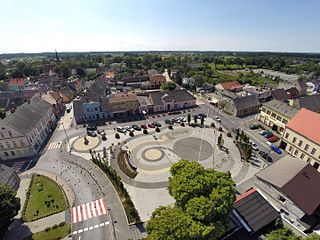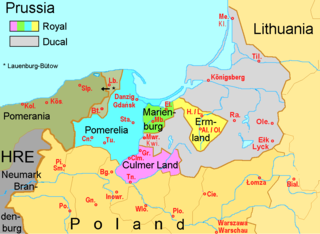See also
- Nazi concentration camps near Bydgoszcz, Poland
- All pages with titles containing Bromberg
- Bromberger (disambiguation)
Bromberg , or Bydgoszcz, is a city in Poland.
Bromberg may also refer to:

Bydgoszcz is a city in northern Poland, straddling the meeting of the Vistula with its left-bank tributary, the Brda. It is at the crossroads of two historic regions: Pomerania and Kuyavia.

Reichsgau Danzig-West Prussia was an administrative division of Nazi Germany created on 8 October 1939 from annexed territory of the Free City of Danzig, the Greater Pomeranian Voivodship, and the Regierungsbezirk West Prussia of Gau East Prussia.

Bromberg was the northern of two Prussian administrative regions, or Regierungsbezirke, of the Grand Duchy of Posen (1815–1848) and its successor, the Province of Posen (1848–1919). The administrative center was the city of Bromberg (Bydgoszcz), which is now part of Poland.

The Bromberg district was a Prussian district that existed from 1772 to 1807 and then from 1815 to 1920. It initially belonged to the Netze District and from 1815 it was part of Regierungsbezirk Bromberg in the Grand Duchy of Posen and from 1848, the Prussian Province of Posen. The city of Bromberg was detached from the district and formed its own urban district since 1875. Today, the territory of the district is part of the Kuyavian-Pomeranian Voivodeship in Poland.

Kreis Hohensalza was one of many Kreise (districts) in the northern administrative region of Bromberg, in the Prussian province of Posen from 1815 to 1919. Its capital was Hohensalza (Inowrocław).

Kreis Wirsitz was one of 14 or 15 Kreise in the northern administrative district of Bromberg, in the Prussian province of Posen. The county existed with essentially the same boundaries beginning in 1815 as a German Kreise then from 1919 as a Polish Powiat until 1975. Its administrative center was the town of Wyrzysk (Wirsitz). The county contained additional municipalities such as Bialosliwie, Lobzenica (Lobsens), Miasteczko Krajeńskie (Friedheim), Mrocza (Mrotschen), Nakło nad Notecią (Nakel), Sadki and Wysoka (Wissek) plus over 100 villages. Many villages that had Germanic names were changed to completely different Polish names following World War II, such as Radzicz. In 1954 the central government abolished the commune as the smallest unit of government, dividing the county into 28 clusters. In 1973 municipalities were restored. After the administrative reform of 1975, the territory of the county was divided between the new (lower) region of Bydgoszcz and the region Piła. The territory of the defunct county was annexed by Naklo County, Kujavian-Pomeranian Voivodeship and Pila County, Greater Poland Voivodeship. Wyrzysk was incorporated into Piła County.

King in Prussia was a title used by the Prussian kings from 1701 to 1772. Subsequently, they used the title King of Prussia.

The Treaty of Bromberg or Treaty of Bydgoszcz was a treaty between John II Casimir of Poland and Elector Frederick William of Brandenburg-Prussia that was ratified at Bromberg (Bydgoszcz) on 6 November 1657. The treaty had several agreements, including the Treaty of Wehlau, signed on 19 September 1657 by the Brandenburg–Prussian and Polish–Lithuanian envoys in Wehlau. Thus, the Treaty of Bromberg is sometimes referred to as treaty of Wehlau-Bromberg or Treaty of Wehlau and Bromberg.

Koronowo is a town on the Brda River in Poland, located in the Kuyavian-Pomeranian Voivodeship, 25 km from Bydgoszcz, with 11,029 inhabitants (2010). It is located in the historic region of Kuyavia.
Treaty of Warsaw may refer to:

The Netze District or District of the Netze was a territory in the Kingdom of Prussia from 1772 until 1807. It included the urban centers of Bydgoszcz (Bromberg), Inowrocław (Inowraclaw), Piła (Schneidemühl) and Wałcz and was given its name for the Noteć River that traversed it.

Szubin is a town in Nakło County, Kuyavian-Pomeranian Voivodeship, Poland, located southwest of Bydgoszcz. It has a population of around 9,300. It is located in the ethnocultural region of Pałuki.
Finckenstein may refer to:

The Pomeranian Voivodeship was a unit of administrative division and local government in the Kingdom of Poland and the Polish–Lithuanian Commonwealth from 1454/1466 until the First partition of Poland in 1772. From 1613 the capital was at Skarszewy.

Lauenburg and Bütow Land formed a historical region in eastern Pomerania. Composed of two districts centered on the towns of Lauenburg (Lębork) and Bütow (Bytów), it was on the western periphery of Pomerelia. The land is today part of the Polish Pomeranian Voivodeship.

Osielsko is a village in Bydgoszcz County, Kuyavian-Pomeranian Voivodeship, in north-central Poland. It is the seat of the gmina called Gmina Osielsko. It lies 9 km (6 mi) north-east of Bydgoszcz. It is located in the historic region of Kuyavia.

Sicienko is a village in Bydgoszcz County, Kuyavian-Pomeranian Voivodeship, in north-central Poland. It is the seat of the gmina called Gmina Sicienko. It lies 17 km (11 mi) north-west of Bydgoszcz.

Świekatowo is a village in Świecie County, Kuyavian-Pomeranian Voivodeship, in north-central Poland. It is the seat of the gmina called Gmina Świekatowo. It lies approximately 23 kilometres (14 mi) west of Świecie and 35 km (22 mi) north of Bydgoszcz.

Nowa Tuchola is a village in the administrative district of Gmina Tuchola, within Tuchola County, Kuyavian-Pomeranian Voivodeship, in north-central Poland.

The Netzekreis was a district in Germany from 1919 to 1945. For most of its existence, it was part of the Prussian Province of Posen-West Prussia. Its administrative seat was the town of Schönlanke. Today the territory of the district is part of the Greater Poland Voivodeship in Poland.